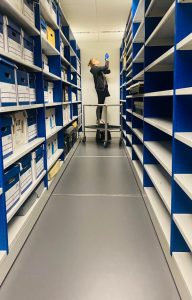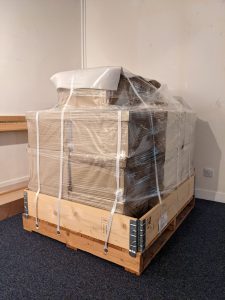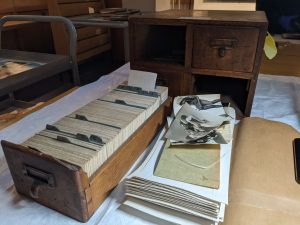Annebella Pollen, Professor of Visual and Material Culture, and Jayne Knight, collaborative PhD candidate (University of Brighton / National Science and Media Museum), discuss their shared experiences in the HSS PGR Research Scheme.
Annebella Pollen: In 2021, I published a new book, Nudism in a Cold Climate: The Visual Culture of Naturists in Mid-20th-Century Britain. In it, I explored how nudists, sometimes known as naturists, developed distinctive approaches to depicting nudes, especially through photography, in a period when moral and legal attitudes to indecency and obscenity were especially convoluted and fraught. Through this research, I discovered the prominent London photographer, Ethelred Jean Straker [1913-1984], professionally known as Jean Straker, who played a key role in successfully petitioning for changes in the law, particularly prohibitions that forbade the photographic depiction of pubic hair.
Straker was a key figure in Nudism in a Cold Climate, and I drew on his publications in the British Library, court papers in the National Archives, and photographic prints and documents in National Science and Media Museum, Bradford (NSMM). But I knew there was more to say beyond his contributions to obscenity trials, and I wanted to continue to explore his story. As a result, I have been interviewing members of Straker’s family and scoping out further collections, including those held in off-site storage at NSMM. Straker boasted several times in the late 1960s that he had produced over 10,000 negatives, and I knew that his scope extended beyond the few nude photographs that he had published, but much of his archive is uncatalogued and under-explored.
To continue my work, I needed help, and so I was pleased to see the Postgraduate Researcher (PGR) Research Scheme introduced in the School of Humanities and Social Science (HSS) at the University of Brighton. This enables staff to appoint PhD students to help with their projects, providing both paid work and research career development opportunities. In early 2022, I was awarded funding for two weeks’ scoping of the Jean Straker Photographic Archive, and the PGR appointed to the role was Jayne Knight.

Jayne Knight photographing archival boxes in the NSMM store, Bradford, 2022. Photography by Lucy Williams, NSMM Photographer. © Science Museum Group.
Jayne Knight: In 2019, I began an AHRC-funded collaborative PhD project between the University of Brighton and NSMM, re-evaluating its Kodak Collection and examining how it has been used to tell the history of popular photography in the museum. Prior to starting the PhD, I completed an MA in Photographic History at De Montfort University and worked with photographic collections in major museums and archives, as well as working on my own family photographic collections.
In February 2022, I began a five-month placement with the curatorial team at NSMM, supported by the AHRC’s Student Development Fund. The placement focused on several areas of the photographic collection, including ephemera, advertising and new acquisitions. It was during my placement that the HSS PGR Research Scheme opportunity arose. I was perfectly positioned to apply, being already based at the museum in Bradford, and with photographic collections handling experience.
Before I could begin scoping out the Straker archive, it first had to be moved from the National Collections Centre (NCC) in Wroughton, Wiltshire. A small part of the archive, mostly relating to Straker’s obscenity trials, was already at Bradford, but the majority had been stored off-site following its acquisition in 2007 from the Straker family. With little research previously conducted on Straker, the uncatalogued archive was a bit of an unknown, both in quantity and in content; it was simply described by the NSMM and NCC teams as ‘two pallets’ of material.

One pallet of material from the Jean Straker Photographic Archive on arrival at NSMM, 2022. Photograph by Jayne Knight.
A decision was made to first transport one pallet to Bradford, as this offered more than enough material to get started with. The pallet first underwent conservation assessment and preservation measures and was then wrapped for transit, keeping its content a surprise until its arrival at NSMM. The van transporting the Straker material also carried several puppets due to be exhibited in the BBC 100 exhibition, ‘Switched On’. These included children’s TV favourites Bill and Ben the Flowerpot Men and Muffin the Mule. The mixed content was a good example of how diverse the NSMM collections can be. Consequently, I awaited the van alongside the exhibitions team as well as the conservators who would ‘condition check’ the pallet prior to any work being done.
On first unwrapping the pallet, I created a listing for the twenty-seven uniformly sized boxes and one smaller box. The pallet, it transpired, almost entirely comprised of 10×8 inch acetate negatives, each sleeved and individually numbered. The smaller box contained a ‘dummy’ (mock-up) of a book by Straker, and a selection of positive prints. Thinking about how to best scope the archive, the archivist and conservators decided that I should use a lightbox to photograph the negatives, which could then later be viewed using digital technology to invert the negative image. This would maximise the material I could record. Unfortunately, condition checking revealed some age-related acetate deterioration, commonly known as ‘vinegar syndrome’ due to its distinctive smell. This meant that the time that I could work directly with the negatives was restricted to short periods. Instead of working on the project in two dedicated weeks, I broke the task down to more dispersed three-hour sessions over several weeks. By the end, however, I was able to document over 1,000 negatives as well as the entirety of an index card filing cabinet that contains Straker’s reference system.

Jean Straker’s file card classification system, NSMM, 2022. Photograph by Jayne Knight.
Annebella Pollen: With over 1,000 negatives newly available for me to study, and with Straker’s cataloguing system recorded in full, thanks to Jayne’s efforts I have been able to gain a much richer understanding of Straker’s working methods and photographic meanings. Straker was a vocal promoter of photography as art at a time – the 1950s and 1960s – when the medium’s artistic status was unstable. He positioned the female nude at the centre of his campaign, restaging historic paintings as well as making modern experiments using mirrors and broken glass, dramatic lighting and shadow techniques. He was also interested in imaginative and psychological vision, and some photographs that Jayne has recorded correspond to his interest in fantasy, with dream sequences staged in his studio. While some photographs reflect Straker’s major interest in sexuality, others are disruptive, surreal and occasionally bewildering, including, for example, theatrical scenarios with dressed acrobats and religious imagery. The new material raises as many questions as it answers, but in conjunction with my other sources, I can now take further steps in my analysis. Jayne’s skilled input has been a boon to my endeavours, and I plan to continue to survey the NSMM collections to develop a new publication on Straker’s life and work, as a lesser known but highly distinctive and productive figure in British photographic history. To that end, in December 2022 I will present a paper at the Censorship and Visual Culture workshop at De Montfort University, entitled Art, Science, Sociology, Pornography? Jean Straker’s Gynaecography in the Dock.

Example of a Jean Straker acetate negative in the Jean Straker Photographic Archive 2007-5009 (digitally inverted). Untitled [group studio scene with acrobat]. Undated [c.1958]. © Science Museum Group Collection.




February 19, 2023 at 9:02 am
Holy cow researchers – you might’ve made yr presentation a bit less abstract & given us poor old foreign geezers a sneak preview of these lovely naked Anglo-Saxon gals. I have always campaigned for the Jean Straker collection ever since I first heard about it circa 1975. Go for it now & bon courage.
Yrs sinc.
RCT
August 10, 2023 at 6:18 pm
I’ve always been a fan of the somewhat overlooked Jean Straker.
You can read more about him and his Arts Club over at:
https://pamela-green.com/jean-straker-and-the-visual-arts-club/
August 10, 2023 at 6:46 pm
Thanks Jesica for your interest. The Pamela Green webpage has some sound outline info about Straker. Our research examines Straker’s full archive, most of which has never been published or previously analysed.
May 17, 2024 at 4:12 pm
I was interested to read your article here. About 40 years ago I purchased a large collection (about 800) Straker studio images as well as some associated bits of ephemera, a copy of the student paper “Oxymoron” with its censor-breaking pubic hair appearance, and some material relating to his anti-censorship work. I obtained these from a naturist writer whose name I am afraid I cannot recall.
Currently I list a few of the photos on ebay from time to time to supplement my pension.
I also, somewhere, have a large collection of negatives and contact sheets by Stepehn Glass, who I am sure you will know of from his naturist work, which I must dig out and see if I can find a buyer for.
May 17, 2024 at 4:28 pm
Dear Allan,
Thank you for your comment. I was interested to read it. I am continuing to work on Jean Straker as a topic. His photographic archive of prints and negatives, court documents and other papers are held in a few public archives. I do see his material for sale on eBay from time to time, so it is interesting to know its provenance! I am familiar with Stephen Glass’s naturist photographs and I used some in my 2021 book, Nudism in a Cold Climate. A collector, Yak El-Droubie, is republishing some Glass-illustrated naturist publications from the 1950s.
Best wishes,
Annebella Pollen